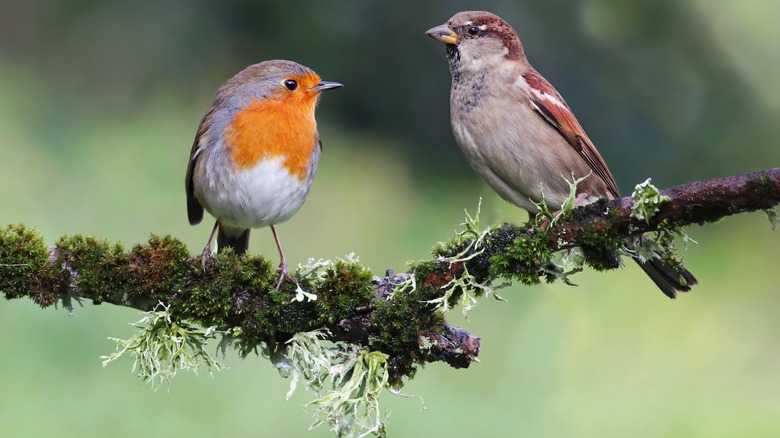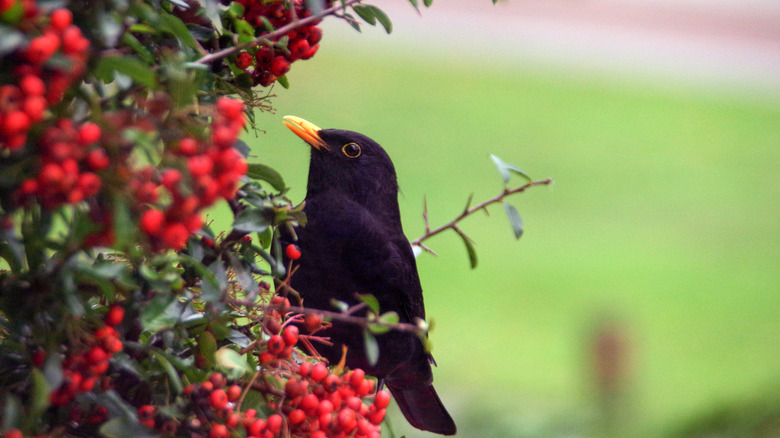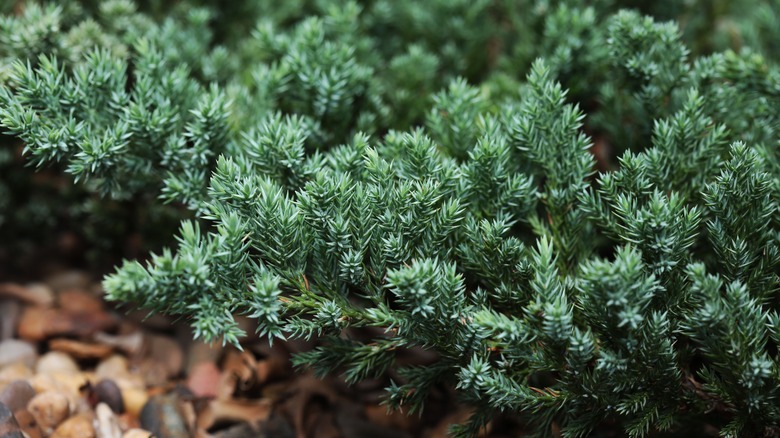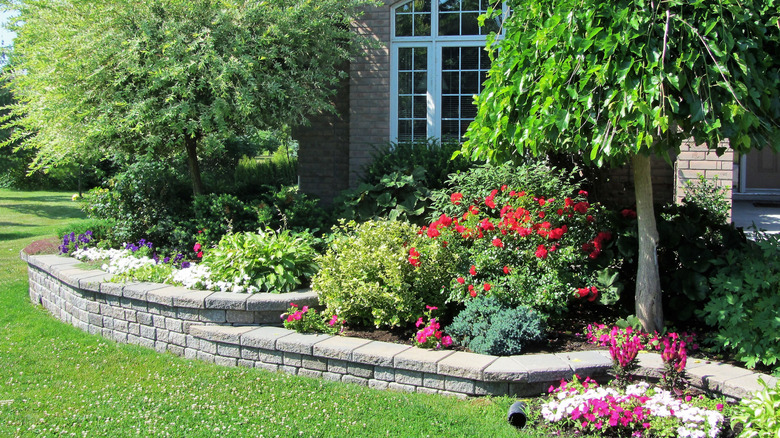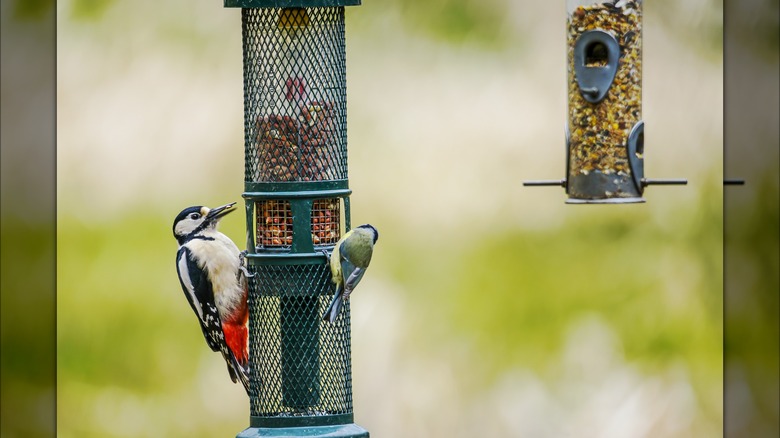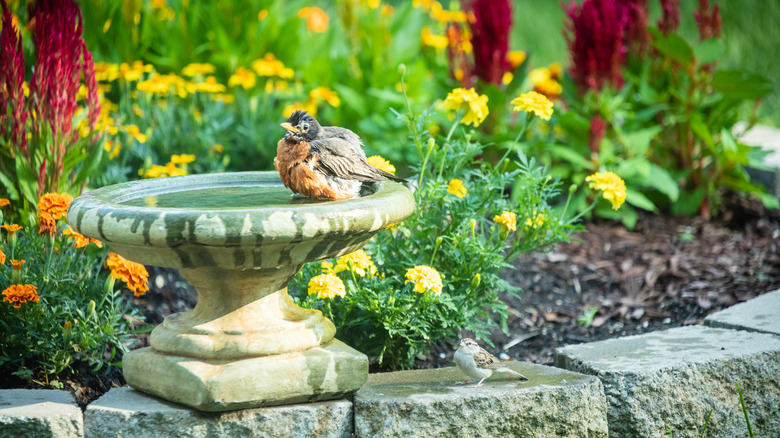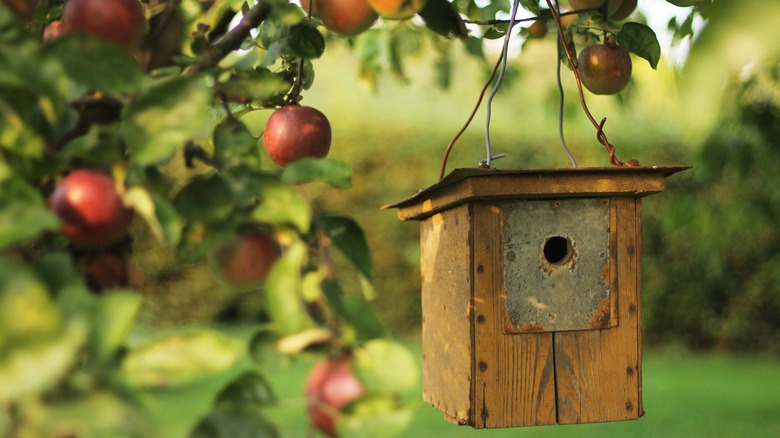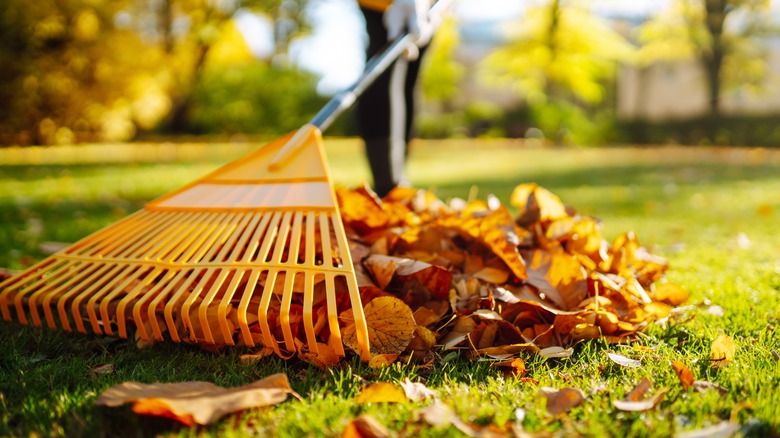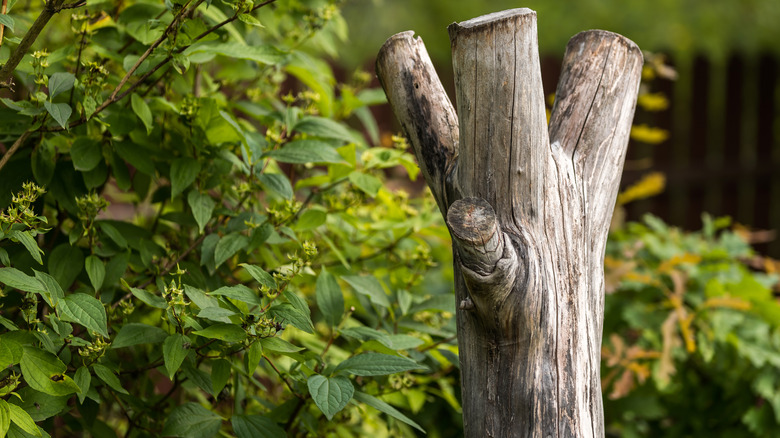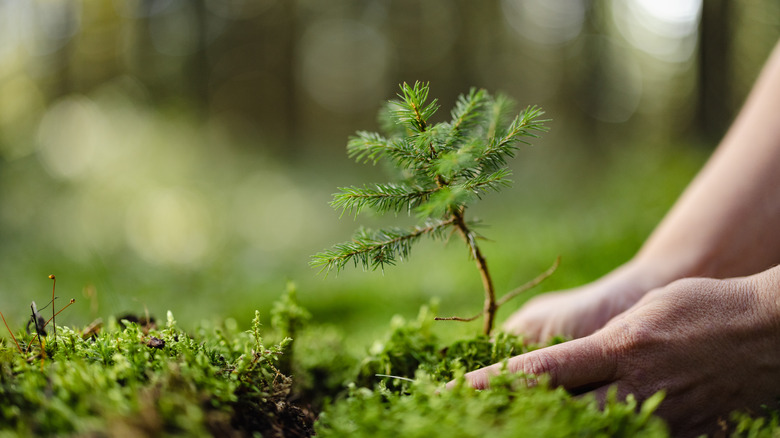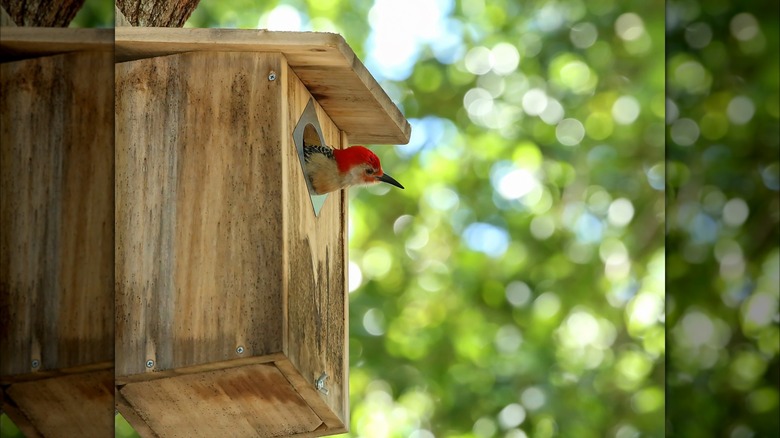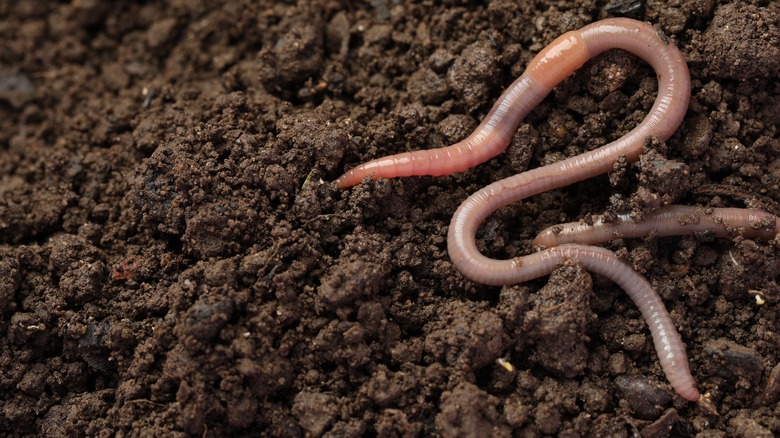Birdscaping Tips To Turn Your Yard And Garden Into A Bird Haven
From a bird's eye view (pun intended), the world has gone to rot. The urban sprawls, the agricultural operations, and the deforested lands have deprived them of their prized habitats and their lives — an argument supported by Cornell Lab's 2019 findings of over 2.9 million birds vanishing in the past half-century. But these sweeping declines can be reversed if you choose to embrace "birdscaping," an approach where you thoughtfully design your landscape around the needs of the feathered species. As it turns out, you don't need a massive area to create a thriving bird haven; even patches measuring ¼ an acre suffice (the average American yard is about ½ acre wide per Today's Homeowner).
Although the golden question is "Why bother?" That's because birds are central to biodiversity. Without them, plants will have a hard time pollinating and building climate-resilient mechanisms. Pesky critters will run amok in your home and garden. Worse, you'll lose your connection with Mother Nature, a relation critical for healthy well-being. So, to not miss out on these benefits, plan a yard that offers the complete package of shelter, food, water, and nesting spots. Native plants, bird feeders, water features, roost boxes, and snags are some of the major requirements, as we discuss below. However, don't turn your yard into an ecological trap by overusing pesticides, letting your cats out, or mowing the turf mid-season, or you'll be left wondering why birds are avoiding your yard.
Draw a plan keeping bird visitors and their requirements in mind
Birdscaping your garden may sound intimidating, but it doesn't have to be. Instead, there is a high probability that your space is already stocked with the basics. This means the trees lining your property, the colorful flower beds, and the tall ornamental grasses are essentially the foundation you can build upon. Of course, you'll have to rejig things a little, depending on the kind of birds noshing in your garden and the ones you wish to attract. For instance, while there may be no dearth of year-round visitors, such as blue jays, American robins, and cardinals in your yard, fly-by migrants like ruby-throated hummingbirds, warblers, and pine siskins could be skipping it completely. Chances are your plant mix is partly to blame.
So, think hard about the missing guests and create a list of their requirements. Project FeederWatch has a helpful resource you can dip into. Next, take stock of the plants already growing in your garden and determine whether they're a good fit. For example, if you're targeting winter browsers (think waxwings and thrushes), ascertain if your place offers a heady mix of evergreens that will keep them warm mid-winter and set buds to allay their hunger. Similarly, if the aim is to keep spring nesters longer, consider planting fruit-bearing hawthorns and vines. In a nutshell, plant a diversity of shrubbery that provides visual interest, food, and shelter through the seasons.
Reduce the area devoted to turf and incorporate native plants
Approximately 40 million acres of American soil are devoted to turfgrasses. This is unlikely to change anytime soon, given 94% of the population (per Angi) continues to partake in pyrrhic cerebral duels with their neighbors over who has nailed down the manicured look the best (49% think they did better). Sadly, birds don't have the same opinion and will avoid your green patches, all the while opinionating "Wow, so dead." Now, there's no debating lawns make valuable entertaining spaces, and watching pets chase frisbees and children stargaze is an unparalleled pleasure. Plus, they're a great asset for erosion control and improved water absorption on slopes.
But that's where the buck stops at the ecological end. Lawns don't support wildlife, especially birds, as there's no food (you're likely mowing them before they set seed). They worsen the situation since maintaining their lush look requires copious amounts of pesticides and fertilizers — things birds abhor. So, what's the way out? Carving out a non-functional area of the lawn and replacing it with bird-friendly, berry-producing, native plants. Creeping juniper, bunchberry, and bearberry are good examples. Doug Tallamy, a conservationist, told Sierra that "If half of American lawns were replaced with native plants, we would create...[a] national park nine times bigger than Yellowstone." But if you aren't willing to jump ship, give in to your lazy tendencies and attract more ground-feeding birds like sparrows by keeping grass long (aka mowing infrequently).
Create a multi-leveled native planting design
Although choosing between native and non-native plants is more complicated than it looks, the fact is: native birds are more familiar and have likely co-evolved with native plants, making a case for growing them. Mariette Nowak, a former director of Wehr Nature Center, elucidated in the Milwaukee Journal, "Even a regular feeder bird like the chickadee has been found to visit feeders for only 21% of its food, preferring the food offered by native plants and insects for most of its diet." However, you can't follow a boilerplate planting approach since birds have their penchants. Some enjoy fruits while others gorge on insects. Similarly, some prefer feeding on the ground, while the rest have distinct preferences for elevation (think varying canopy levels) that may change over their lifecycle — and this applies to shelter and nesting habits, too.
So, layer your native plants, provided they abide by your site's conditions (sun, soil, and blooming times). Start by planting diverse, locally adapted native wildflowers (milkweed and black-eyed susan) and ornamental grasses (little bluestem) that bring a wash of color to your yard and provide much-needed fruit and bugs for birds. Continue outwards by planting shrubs (viburnums), finally lining the edges with tall trees (especially oaks). This'll also help the birds escape the clutches of predatory animals. Ensure the shrubbery flows into each other, as mixed zones offer the best perch spots. If you're targeting hummingbirds, pay attention to colors (vivid reds and oranges work better).
Put up multiple feeders to attract different bird varieties
Although birds aren't completely dependent on the plant-based, bud-to-bird buffet you've laid out for them for food, they appreciate some help during late winters when such supplies are exhausted. However, the food must be to their liking and accessible at their feeding height. Safe exit routes are appreciated. Naturally, a single bird feeder cannot cater to the demands of a diverse legion of feathered chums.
So, intersperse several feeders in your garden at varying heights, holding distinct food based on the common visiting varieties. For instance, raised feeders attract blue jays and purple finches, but northern cardinals and starlings are drawn to ones placed at shrub-level heights. Similarly, most woodpeckers and Northern flickers flock to suet-based hanging feeders. Conversely, ground-feeding birds, like juncos, sparrows, and common grackles, avoid feeders, other than tray feeders. They would much rather you create a false slope by heaping soil and marking it with a stone. During the growth season, it could support seed-producing plants and insects (thanks to the rock); during frost, you could spread a few seeds of your own accord.
Size matters, too. Small birds pivot toward tube feeders, while the bigger ones prefer hopper feeders. Moreover, all bird feeders should be placed close to cover, but no closer than 15 feet lest squirrels have their way, so birds have an escape route. But in smaller yards, the feeders should be within 10 feet of the home's windows to minimize damage if the bird flees.
Place a water feature near cover
Water is essential for both birds and your birdscaping. How else would you catch them in the act of quenching their thirst and preening their rumpled feathers? Luckily, you don't have to go all fancy, putting up expensive commercial offerings; a charming DIY bird bath you made works, too. Obviously, it must offer good footing, meaning smooth or glossy, plastic surfaces are a no-go unless overlaid with stones. Moreover, it must have a provision for heating or de-icing to be useful during the winter when most water sources are frozen solid. Also, it should mimic natural water sources, offering a gentle slope into a 2 to 3-inch-deep dish.
Additionally, it must be placed at the right location. If you think all feathered friends rejoice hovering over a hanging bird bath or the ones sitting high on their regal pedestals, you're in for a surprise. While they woo in house finches and chickadees, they deprive you of the ground-loving, large birds, like doves and robins. Unsurprisingly, ground bird baths have their problems, with cats, small mammals, and predatory birds getting an easy meal. The lone solution is to place them around shrubs where birds can cower when facing danger, but not underneath bird feeders (ugh, the cleanup!). Shaded locations work better in hot climates. To charm hummingbirds, affix a mister on your hose and watch the ephemeral scene unfold. If your budget allows, install a backyard fountain, as birds like moving water.
Keep nesting materials and birdhouses near feeders
Most birds are on the lookout for nesting materials, like straw, yarn, and animal hair, around spring to build a home to lay their eggs and watch their offspring soar to the skies. This presents a brilliant opportunity to invite in an array of different feathered varieties. You just need to keep a supply of such materials in their sight line, perhaps in and around the feeders or over herbaceous shrubbery.
And, if you've got space to spare, you can choose the best type of birdhouse for your yard based on the birdies you want to invite over. Remember, only secondary-cavity nesters value birdhouses, as they love to hole up in an abandoned cavity if they can't find a natural hollow. Great-crested flycatchers, mountain bluebirds, and tree swallows fall under this category, although northern flying squirrels might gate crash the party, too. It's important to get the location, mounted height, and size of the birdhouse right. To put this into perspective, tree swallows want a house near a water feature, but chickadees like your woody trees. Similarly, some demand their houses be hung from a freestanding metal post at a height of five feet with predatory guards on. Moreover, to ensure complete privacy, each birdhouse should be 25 feet away, limiting the total to 10 for every acre.
Ditch the fall cleanup
If you have heaps of leaf litter gathered in your garden beds, it's time people recognized your exceptional diplomatic service to our feathered friends. Although fall is the season of countless gardening chores, birdscaping offers respite from a few of them.
For starters, you should think twice before trimming up the yard this fall. In other words, let the perennials, ground covers, and ornamental native grasses be, even though their standing foliage doesn't fit the mold of "winter interest." The reason? They retain fruit and seeds (if not given a haircut) that come in handy for birds when other food sources become scant mid-winter. Moreover, they double as shelter spots for birds hiding from frost, gales, or aerial predators. Not to mention, migratory birds treat the spent foliage as rest stops.
Additionally, the shed foliage harbors overwintering bugs, insects, and other critters, which become delicious sources of much-needed protein for birds, ultimately helping them keep warm until spring waltzes in. This step is particularly crucial for ground feeders, including juncos, mourning doves, thrashers, and towhees. So, instead of discarding or composting the leaves, cut them down into smaller pieces and use them around shrubs as mulch. Soil enrichment is a bonus advantage.
Retain some snags in your yard
Despite your best efforts, some trees in your yard can begin dying in part or fully, either of natural causes or because they sustained excessive damage from fire, lightning, animal action, or disease, calling their safety into question. Unless they're located too close to your home, pose a risk of toppling over and damaging the structure or adjoining plantings, consider leaving the dead trees (the snags) in their place. Or, err on the side of caution and cut them down to 15-foot-tall stumps to entice birds and other wildlife — you can also brace them with cables.
Given their intense "fixer-upper" predisposition, the woodpecker species, including the near-threatened red-headed woodpecker, hairy woodpecker, and pileated woodpecker, fancy drumming into the dead wood to create their nesting cavities. This rouses their reproductive tendencies, too. Likewise, other varieties like American kestrel, tufted titmouse, black-bellied whistling ducks, Carolina chickadees, and some owls take up residence in a snag's cavities.
Decaying, soft snags also serve as excellent foraging grounds. Most birds, especially nuthatches and woodpeckers, love to pick off insects homing inside the tree holes. Predatory birds, including falcons, owls, and raptors perch on top of the snags to screen the area for prey. Band-tailed pigeons and swallows use the dead stumps as highway rest stops. You might even snag a front view of the dating-and-mating show put on by trilling songbirds.
Grow evergreen trees to provide food and shelter mid-winter
Not all birds like squeezing their bodies in a rugged tree cavity, regardless of the cold. In its place, they seek shelter in evergreen trees. Thus, homeowners desirous of creating a blissful bird haven should consider covering at least a one-tenth of their garden area with native evergreens. American Holly, Southern magnolia, Swamp bay, and various conifers are incredible options, but ensure they're well-adapted to your local environment and site conditions, or look for recommendations at nursery centers or local extensions. You can also put your Christmas tree outside once it's accomplished its task and chuckle at birds bemused by the errant red ornaments. Just discard the tree once it sheds its needles.
Not only will the snow-draped trees look picturesque in the otherwise dead winter, but they also prevent the icy drafts and icy conditions from hurting the foraging birds. Plus, they put out delicious fruits and seeds that birds find appetizing, supplementing your bird feeders during the winter chill. And if they have cavities, prepare yourself for some chirpy baby chicks. Evergreens also function as safe zones for songbirds when their hunters are on the prowl for a scrumptious feast. But if you aren't game for tall trees, you can help the songbirds out by growing thickly branched or prickly deciduous shrubs like maple-leaf viburnum or inkberry.
Adorn your yard with brush piles and roost boxes
If you've conditioned yourself into keeping the gardens tidy and organized and balk at the idea of preserving the fall mess, fret not because brush piles are your new best friend (for birds, too). Small birds, including Carolina wrens, tufted titmice, warblers, and black-capped chickadees, treat nature's woody potpourri as their winter Airbnb. This way, the snow-capped brush traps heat, rendering much-desired warmth to the roosting birds. There is another fascinating aspect to brush. Birds of prey play their waiting game sitting opposite these piles since they're used by small mammals as hidden tunnels. Some foraging birds may also flock to it in hopes of encountering conifer or birch seed droppings.
Making a brush pile is a breeze. Simply gather the limbs you pruned during the fall and stack them by size — the shorter logs sit atop their longer companions. Throw the bare Christmas tree and the dropped leaves into the collection if you like. Don't be alarmed if overwintering sparrows or ruffed grouse commune nightly in the pile — they're just trying to keep cozy. To up the ante, decorate your yard with roost boxes; nuthatches and bluebirds will populate them in no time. Alternatively, you can repurpose your birdhouse for winter birds by taping its drainage holes and moving it to a sunny spot.
Stock up on insects, worms, and bugs
Although loads of gardeners use tips and tricks to prevent birds from munching garden fruit before they've had a chance, the reality is that 80% of the bird varieties, like swallows and nightjars, are more inclined toward nibbling down insects. Surprisingly, even if the bird in question is frugivorous (eats fruits), it will still feed its hatchlings copious amounts of insects to meet their requisite protein requirements. Moreover, they rely on accessing a ready supply of snakes, lizards, and skinks to fulfill their nutritional requirements. In turn, these creatures hazard a visit to your yard while hunting for insects. So, what are the implications of this food chain? You can attract birds by playing host to insects. Naturally, native plantings and brush piles help, given their knack for supporting native insects. But all your effort will go down the drain if you choose to control "pests" with pesticides.
Generally, most of the insects visiting your yard are beneficial or neutral parties on a walk. However, the 1% gives the rest a bad name by wreaking havoc on your flower beds. Although the right cultural practices or herbicidal soap treatments take care of most of the pesky critters, some choose to chemically treat their yard with non-selective, neonicotinoids-based insecticides. This destroys this valuable food source while turning fatal for the birds: over 72 million birds have lost their lives to poisoning (per the U. S. Fish & Wildlife Service).
